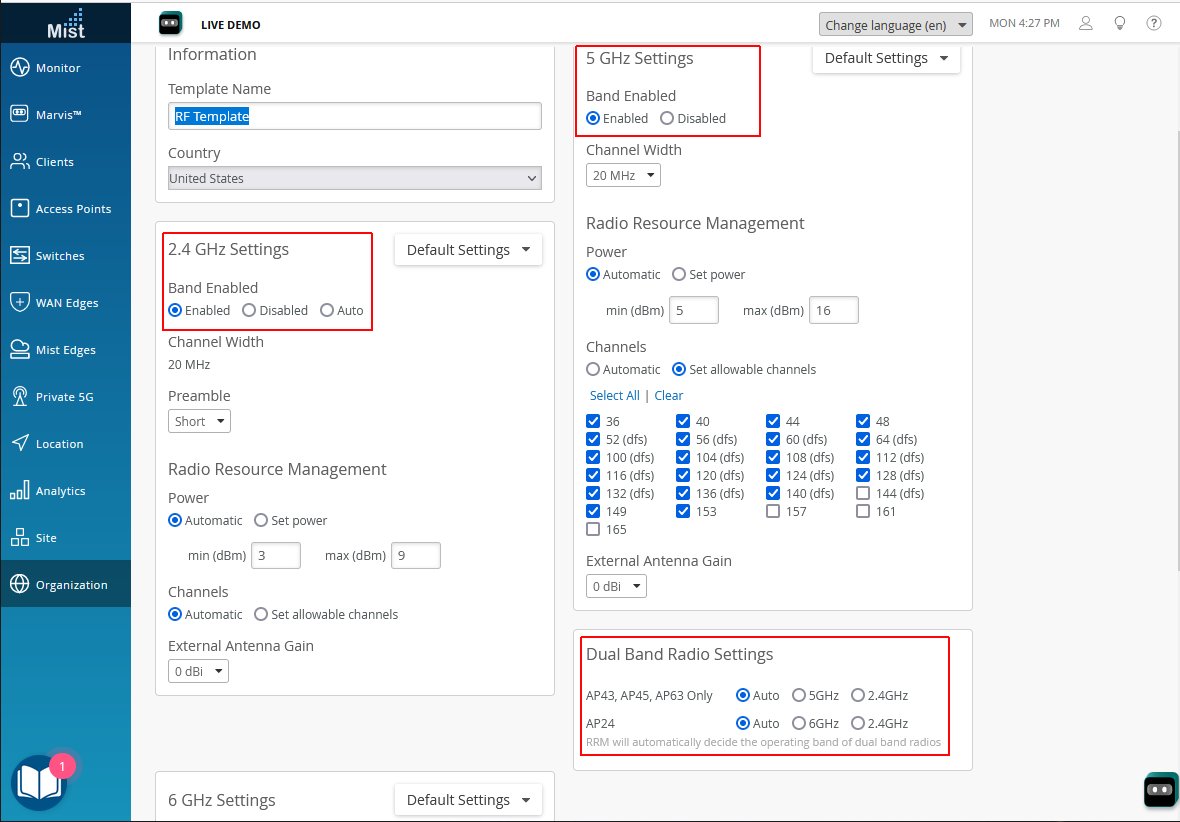Radio Management (dual-band)
By default, APs with two radios operate both the 2.4-GHz and 5-GHz radio bands. For AP models that support "dual-band," you can have the AP automatically convert the 2.4-GHz radio to 5-GHz (or 6-GHz for AP24, AP34, AP45, AP45E, and AP64). This is especially useful in high-density environments because the 5-GHz band can provide up to 25 non-overlapping channels, whereas only three or four are possible in the 2.4-GHz band. See Radio Management and Enable Fast Roaming.
For APs that don't support auto-conversion, 2.4-GHz radios that are found to be surplus to necessary coverage can be automatically disabled.
This discretionary behavior is especially useful in the context of templates because you don't need to worry about model-specific exceptions. For mission critical or 2.4-GHz IoT devices, we recommend managing the radio bands manually. You would use auto RRM, on the other hand, to simplify radio management when there are many APs or sites involved.
The figure below shows a dual-band radio configuration with automatic radio management as configured in an RF Template (Organization > Wireless | RF Template). See Templates and Device Profiles.

As the figure shows, you enable both the 2.4-GHz and the higher band radio (5-GHz here), and then also enable Auto under dual-band Radio Settings.
-
When auto is enabled, the typical cancellation/conversion is 20-40 percent of APs in a site.
-
When auto is enabled, it will not disable more than 50 percent of the 2.4-GHz radios in a site.
-
When using auto-conversion or dual 5-GHz, we recommend 20 MHz-channel widths to maximize the number of 5-GHz radios.
Dual-band Radio Settings
There is no On/Off toggle to enable or disable dual-band radio in the Mist portal. Instead, you need to enable both radios on the AP and then setting dual-band to Auto. The AP will then use the scanning radio to determine whether the 2.4-GHz radio can be converted to 5-GHz (or disabled if conversion is not supported on the AP).
-
Auto (Auto Conversion)—The following default behaviors apply to dual-band and non-dual-band APs.
-
Dual-Band APs (AP43 and 63)—If there are APs located close enough together that they can cumulatively provide enough 2.4-GHz band signal to cover the whole area, there are some important things to note. For those APs where the 2.4-GHz band radio is not needed, the 2.4-GHz band radio will be converted to operate on the 5-GHz radio band, and the 5-GHz channels will be divides like so:
-
Dedicated 5-GHz: 36 -64
-
Dual-band 5-GHz: 100 -165 (as per the bandwidth)
-
-
Non dual-band APs—If there are APs located close enough together that some of the APs can cumulatively provide enough 2.4-GHz band signal to cover the whole area, then for those APs where the 2.4-GHz band radio is not needed, the 2.4-GHz band radio will be turned off.
-
When both radios on an AP are broadcasting 5-GHz, the radios will divide the 5-GHz channels as shown in the following table to ensure sufficient separation:
Dual 5-GHz Radios
-
- Dual-band Radio (5-GHz) – Channels 100-165
- 5-GHz Radio – Channels 36-64
-
AP45 (only)
- Dual-band Radio (5-GHz) – Channels 36-64
- 5-GHz Radio – Channels 100-165
Dual-band 2.4-GHz and 5-GHz (or 6-GHz)
-
- Dual-band Radio (2.4-GHz) – All 2.4-GHz channels
- 5-GHz Radio – All 5-GHz Channels
